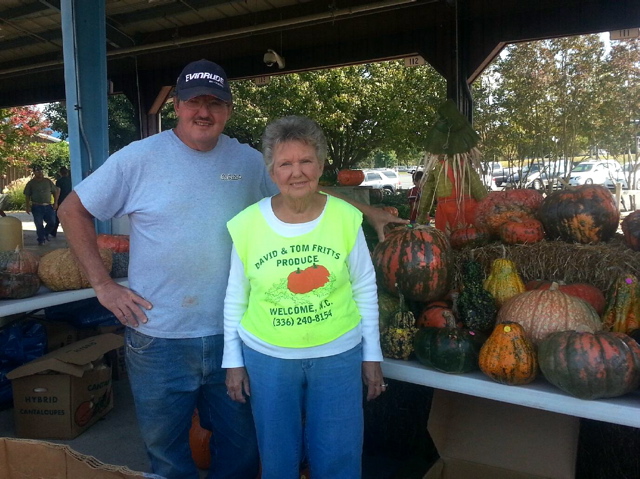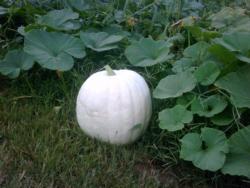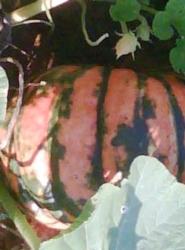Back Story: David Fritts, world-class pumpkin grower

“The reason why Eufaula is my favorite tournament lake is because…” I never do find out why David Fritts thinks so highly of Lake Eufaula, as his cell phone rings for the umpteenth time and his attention is diverted. It’s another customer, with money to spend. Fritts is talking business again.
The typical angler’s thoughts might turn to autumn fishing and the big transition of deep-water fish back toward the shallows, which is what’s on my mind as we crank a creek ledge on Oklahoma’s Grand Lake. We’re trying out the reborn BB1 baitcaster that Lew’s introduced at the 2012 ICAST show, but Fritts’ focus wavers momentarily from bass and tackle. This time of year, he’s in to pumpkins – big time. Back home in the Carolina Piedmont, the Fritts family is known far and wide for the quality and quantity of the pumpkins it grows: large ones and little ones in every shape, texture and hue. Pumpkins seemingly bubble out of the ground on the Fritts farm near Lexington, N.C., and most of them – upwards of 75,000 per year – will wind up on somebody’s stoop at Halloween or in somebody’s home at Thanksgiving as a decoration or in a pie.
The 2012 harvest is in, and as he has done for the last 10 years or so, David Fritts will spend most of October dealing with buyers either in person or over the phone. When Fritts isn’t available – such as when he’s fishing a tournament – his nephew, Phillip Sink, takes care of things.
“I started out just growing pumpkins just for the heck of it, but it gradually grew to the point where now we plant about 125 acres with pumpkins,” says Fritts in between phone calls from customers. “The business seems to get a little larger every year and we employ a good many local school kids to help us get them in. It’s gotten to be a pretty big deal.”
No surprise, Jack-o-Lantern pumpkins – the 5- to 15-pound size that have become a hallmark of Halloween – are the biggest sellers for David and his father, Tom, who operate David and Tom Fritts Produce Market in the community of Welcome, N.C. Besides Jack-o-Lanterns, they grow a few table-grade heirlooms, such as Seminole and Texas Sweet Potato. But the pumpkins that really get David fired up are the exotics that he sells for “display.”
 “Orange is the main color everybody thinks about, but pumpkins come in all sorts of colors,” adds Fritts. “We grow whites and pinks, blues and grays, red and black, red with black and green, white with orange stripes and so forth. These are some really good-looking pumpkins; they look like they’re made of porcelain. It’s like the colors were painted on. Most of these types of pumpkins are table pieces for Thanksgiving. The other day we sold a green pumpkin with orange polka dots for $75. Some people don’t want the same thing as everybody else has got.”
“Orange is the main color everybody thinks about, but pumpkins come in all sorts of colors,” adds Fritts. “We grow whites and pinks, blues and grays, red and black, red with black and green, white with orange stripes and so forth. These are some really good-looking pumpkins; they look like they’re made of porcelain. It’s like the colors were painted on. Most of these types of pumpkins are table pieces for Thanksgiving. The other day we sold a green pumpkin with orange polka dots for $75. Some people don’t want the same thing as everybody else has got.”
Planting time begins in May and might extend into late July, depending on the variety of pumpkin and how long it takes to mature before the October harvest. Fritts plants seeds about 3 or 4 feet apart in rows that are 6 to 8 feet apart, so the vines have plenty of elbow room to ramble. The critical part of the growing season is after the flowers are fertilized by flying insects, and set fruit.
The bulk of North Carolina’s pumpkin crop is grown in the verdant mountain valleys of the Appalachians, and summers can be harsh in the Piedmont where Fritts’ pumpkin patch is. He relies on an irrigation system to get his crop through the hottest and driest days of summer. But too much rain is also a threat, and even a few days of heavy fog can promote fruit rot. Either way, flowers or fruit can drop off the vine. If that happens, he has to start all over – if there’s time enough.
 Despite the heat and drought that troubled much of the nation, this year’s crop was good: Cinderellas, Fairytales, Valencianos and all the rest reached their full maturity at about the same time and kept the Fritts family busy cutting pumpkins from their vines and readying them for market. Beside the bulk buyers, David’s mother Frances sells about $1,500 worth of pumpkins on a good weekday at their market, and from $5,000 to $7,000 worth on a fall weekend.
Despite the heat and drought that troubled much of the nation, this year’s crop was good: Cinderellas, Fairytales, Valencianos and all the rest reached their full maturity at about the same time and kept the Fritts family busy cutting pumpkins from their vines and readying them for market. Beside the bulk buyers, David’s mother Frances sells about $1,500 worth of pumpkins on a good weekday at their market, and from $5,000 to $7,000 worth on a fall weekend.
Fritts has won just about every major angling accolade possible, including the Bassmaster Classic in 1993 and the Forrest Wood Cup in 1997. He’s had his share of fame and glory and it takes a lot to impress him, but a patch full of ripening pumpkins will do it.
“It’s not something where you make a lot of money,” says Fritts of his pumpkin farm. “It’s more about seeing a small vine come out of the ground and watching it turn into something beautiful. It gives me a lot of satisfaction. That’s the only way I can explain it.”